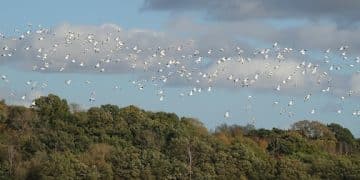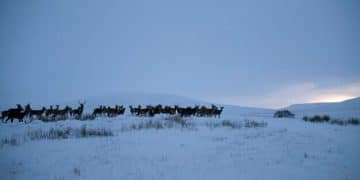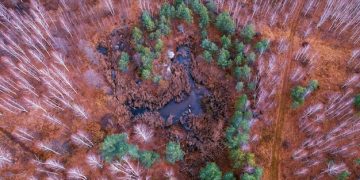Wildlife Migration in the US: Tracking and Conservation Efforts
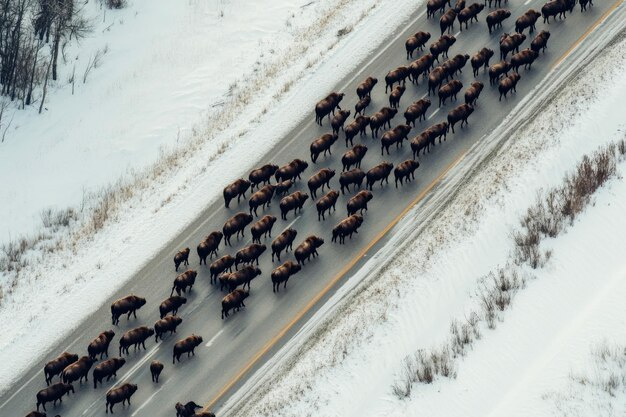
Understanding Wildlife Migration Patterns: Tracking Changes and Protecting Key Corridors Across the US involves studying animal movements, addressing habitat fragmentation, and implementing conservation strategies to ensure the survival of migratory species.
Understanding Wildlife Migration Patterns: Tracking Changes and Protecting Key Corridors Across the US is crucial for effective conservation. These patterns are increasingly affected by climate change, habitat loss, and human development, making monitoring and protection efforts more critical than ever.
The Importance of Understanding Wildlife Migration
Wildlife migration is a fundamental ecological process essential for the health and survival of numerous species. It involves the seasonal movement of animals from one region to another, often in search of food, breeding grounds, or more favorable climate conditions. These migrations can span vast distances and play a critical role in maintaining biodiversity and ecosystem stability.
By studying these patterns, we can better protect vital habitats and migration routes. This knowledge is crucial for informing conservation strategies and mitigating the negative impacts of human activities on wildlife populations.

Reasons for Migration
Animals migrate for a variety of reasons, primarily related to survival and reproduction:
- Access to Food: Many species migrate to areas where food is more abundant, especially during specific seasons. For example, birds may fly south for the winter to find insects and fruits.
- Breeding Opportunities: Some animals migrate to specific locations that provide ideal conditions for breeding and raising their young. Salmon, for instance, return to their natal streams to spawn.
- Climate Conditions: Migration allows animals to avoid harsh weather conditions, such as extreme cold or drought. Caribou, for example, migrate to warmer areas during the winter.
Understanding these drivers is key to predicting how migration patterns may change in response to environmental factors.
In conclusion, studying wildlife migration helps us understand the complex interactions within ecosystems and the steps needed to ensure the survival of migratory species.
Tracking Methods: From Traditional to High-Tech
Tracking wildlife migration patterns has evolved significantly over the years, from traditional observation methods to advanced technological approaches. These methods provide valuable data on animal movements, habitat use, and behavior, which are essential for conservation efforts.
Modern tracking technologies offer unprecedented insights into the lives of migratory animals. By combining these methods, researchers can gain a comprehensive understanding of migration patterns and the factors that influence them.
Traditional Methods of Tracking
Early methods of tracking wildlife relied on direct observation and physical marking techniques:
- Visual Observation: Observing animals in their natural habitat and recording their movements.
- Capture-Mark-Recapture: Capturing animals, marking them with tags or bands, and then recapturing or resighting them to track their movements over time.
Technological Advances in Tracking
Advancements in technology have revolutionized wildlife tracking:
- GPS Tracking: Attaching GPS devices to animals to record their location data.
- Satellite Telemetry: Using satellite-linked transmitters to track animals over long distances.
- Acoustic Monitoring: Deploying acoustic sensors to detect and record the calls of migratory species.
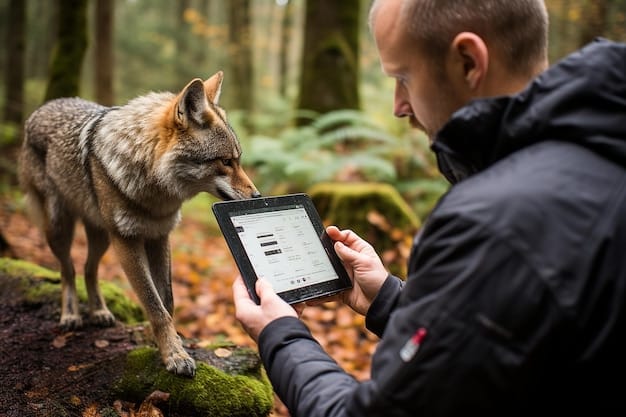
These advancements have greatly enhanced our ability to monitor and study wildlife migration.
In conclusion, tracking methods have evolved from basic observations to sophisticated technologies like GPS and telemetry, providing in-depth insights into wildlife migration patterns and aiding conservation efforts.
Impact of Climate Change on Migration Patterns
Climate change is significantly altering wildlife migration patterns around the world. Rising temperatures, changing precipitation patterns, and more frequent extreme weather events are disrupting traditional migration routes and affecting the timing and success of animal movements.
These changes pose significant challenges for migratory species, as they struggle to adapt to rapidly changing environmental conditions. Understanding these impacts is crucial for developing effective conservation strategies.
Altered Timing of Migration
Climate change is causing many species to migrate earlier or later in the year, disrupting their synchrony with food availability and breeding opportunities:
- Earlier Spring Migrations: Warmer temperatures can trigger earlier plant growth and insect emergence.
- Delayed Autumn Migrations: Warmer temperatures can extend the growing season, delaying the onset of winter conditions.
Habitat Shifts
Climate change is also causing shifts in habitat ranges, forcing species to migrate to new areas:
- Poleward Shifts: As temperatures rise, many species are moving towards the poles in search of cooler climates.
- Altitudinal Shifts: Mountain species are moving to higher elevations to escape rising temperatures.
These shifts can lead to increased competition and conflict with resident species.
In conclusion, the changing climate significantly affects migration patterns, causing shifts in timing and habitat use, thereby necessitating informed conservation strategies to mitigate the effects.
Habitat Fragmentation and Loss: Threats to Migration Corridors
Habitat fragmentation and loss are major threats to wildlife migration corridors. As natural habitats are converted for agriculture, urban development, and infrastructure projects, migratory species face increasing obstacles in their journeys.
Protecting and restoring migration corridors is essential for ensuring the survival of migratory species. These corridors provide safe passage for animals as they move between seasonal habitats.
Causes of Habitat Fragmentation
Several factors contribute to habitat fragmentation:
- Urban Development: The expansion of cities and towns can destroy or isolate natural habitats.
- Agriculture: Converting forests and grasslands into farmland reduces the availability of suitable habitat.
- Infrastructure: Roads, railways, and pipelines can create barriers to animal movement.
Consequences of Habitat Fragmentation
Habitat fragmentation can have several negative consequences for migratory species:
- Increased Mortality: Animals may be forced to cross roads or other dangerous areas, increasing their risk of being killed.
- Reduced Gene Flow: Isolated populations may experience reduced genetic diversity, making them more vulnerable to disease and environmental change.
- Disrupted Migration Patterns: Barriers can prevent animals from reaching their traditional breeding or feeding grounds.
In conclusion, habitat fragmentation endangers wildlife migration by impeding crucial movement corridors; therefore, protecting and restoring these pathways is vital for the survival of migratory species.
Conservation Strategies for Protecting Migration Corridors
Effective conservation strategies are essential for protecting wildlife migration corridors. These strategies involve a combination of policy measures, habitat management practices, and community engagement initiatives.
By implementing these strategies, we can help ensure that migratory species have safe passage between their seasonal habitats and can continue to thrive.
Policy Measures
Policy measures can play a key role in protecting migration corridors:
- Land Use Planning: Incorporating migration corridors into land use plans to prevent development in critical areas.
- Protected Areas: Establishing protected areas along migration routes to provide safe havens for animals.
- Regulations: Implementing regulations to minimize the impact of human activities on migration corridors.
Habitat Management Practices
Habitat management practices can enhance the quality of migration corridors:
- Habitat Restoration: Restoring degraded habitats to provide suitable food and shelter for migratory species.
- Corridor Connectivity: Maintaining or restoring connectivity between habitat patches to facilitate animal movement.
- Invasive Species Control: Controlling invasive species that can degrade habitat quality and displace native species.
In conclusion, protecting wildlife migration relies on effective strategies that combine protective policies, habitat management, and public commitment.
Community Involvement and Education
Community involvement and education are crucial for the long-term success of wildlife migration conservation efforts. Local communities often have valuable knowledge about migration patterns and can play a key role in monitoring and protecting these routes.
By engaging communities and raising awareness about the importance of migration corridors, we can foster a sense of stewardship and promote sustainable practices.
Community-Based Monitoring
Local communities can assist in monitoring migration patterns and identifying threats to wildlife:
- Citizen Science: Engaging community members in data collection and monitoring activities.
- Traditional Knowledge: Incorporating traditional ecological knowledge into conservation planning and management.
Education and Outreach
Education and outreach programs can raise awareness about the importance of migration corridors and promote responsible behavior:
- School Programs: Educating students about wildlife migration and conservation.
- Public Awareness Campaigns: Launching public awareness campaigns to inform people about the threats facing migratory species.
In conclusion, community involvement is an essential component of successful wildlife migration, emphasizing local knowledge, participation in monitoring, and public education.
| Key Aspect | Brief Description |
|---|---|
| 🌍 Importance of Migration | Essential for species survival and ecosystem stability. |
| 📍 Tracking Methods | Evolved from observation to GPS and satellite telemetry. |
| 🌡️ Climate Change Impact | Alters timing and routes due to rising temperatures. |
| 🚧 Habitat Fragmentation | Threatens corridors, impacting passage for species. |
Frequently Asked Questions (FAQ)
▼
Studying wildlife migration patterns is crucial for effective conservation, as it helps us understand how species are adapting to environmental changes and where their critical habitats are located.
▼
The main threats include habitat fragmentation due to urban development and agriculture, climate change altering migration routes, and human-induced disturbances like roads and poaching.
▼
Climate change alters migration timing and habitat, leading to mismatches with food availability. Species distribution changes, and habitats deteriorate, directly impacting vulnerable migratory behaviors.
▼
Communities can engage in citizen science, support local conservation initiatives, advocate for land-use planning that protects migration corridors, and educate their residents on responsible practices.
▼
GPS tracking and satellite telemetry are commonly used, involving electronic tags and devices attached to animals. These collect and transmit precise movement data facilitating detailed migration analysis.
Conclusion
Understanding and protecting wildlife migration patterns is vital for preserving biodiversity and ensuring ecosystem health across the US. By using advanced tracking methods, addressing habitat loss, and mitigating the impacts of climate change, we can support the long-term survival of migratory species and the ecological balance they contribute to.

